How to stretch your tight Rectus femoris safely
Sherwin Nicholson Hon.Bsc. |Updated Dec 1, 2022
Is your rectus femoris (Rf) tight? How you can tell.
The right stretches will help you right away, so scroll/swipe to the bottom of this page!
Usually you would not experience any soreness from this muscle itself unless you have strained it from over use. This could be from an intense and highly explosive sporting activity such and running or jumping.
Other sports could include team sports which involve kicking, gymnastics or even martial arts.
Prolonged sitting can cause this muscle to tighten. The lack of activation from sitting for too long weakens it and causes the muscle to fatigue faster.
Because of fatigue, it then tends to strain, which leads to it becoming shorter. Sitting causes the R.femoris (Rf) at an angle to further shorten which only makes the problem worse.
These type of activities can spell trouble if not properly looked after.
In these difficult days of COVID-19, we are faced with the reality of not having enough access to physical activity as before. This is why it’s even more important to protect your body from preventative health problems such as back pain. Your rectus femoris is one of the biggest contributors to this pain!
It is therefore very essential for you to take the time to stretch your Rectus Femoris!
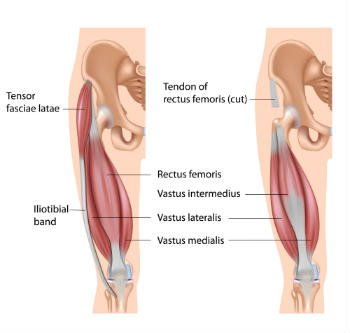
The Rectus femoris crosses both the hip and knee joint
It’s One of the Most Important Quadriceps in Your Leg!
Your rectus femoris is one of your quadricep muscles (in addition, is the vastus lateralis, vastus medialis and vastus intermedius). It’s the only one of the group that crosses over both your hip and knee joint.
From the diagram above, you can see that it attaches from your pelvis and travels down to join the other quadricep muscles to together attach at the tendon of the knee.
So as you would predict, any issues such as a strain, inflammation, a tear or tightness would affect both your hips and your knees.
Of the quadriceps group, the Rf is the only one that you can adequately stretch on your own.
Once this very essential and constantly active muscle fatigues, it’s only natural that the stability of your hip, pelvis and knee would become worse.
To avoid from suffering from Rf tendonitis, you need to stretch this muscle on an ongoing basis carefully.
Tight quads and knee pain
One sure sign of tightness is knee pain. Often it’s a combination of this muscle along with any imbalances between the vastus medialis and the vastus lateralis. The key is to stretch the Rf while strengthening the medialis to offset the lateralis.
When the quadriceps are thrown off balance from overuse or lack of adequate conditioning, you are very likely to have problems with your knee cap.
The pain associated with this imbalance is known as patello femoral pain syndrome (PFPS). Tightness also causes your knee joint to hyper extend, causing strain on the cruciate ligaments.
This leads to a misalignment of the knee cap as it tracks along your knee joint during a movement. You are likely to feel a sharp pain coming from the anterior/front part of the knee cap. It is very noticeable when you bend your knee to a specific angle causing you to feel a sharp pinch.
Most people tend to believe that there is a problem with the knee itself when it is actually the muscles that stabilize it.
Tight Quads and Hip Pain
When your quads tighten up, it inevitably affects your hips because of where they attach on the pelvis. Sitting at work, while driving and also during leisure worsens this problem.
You will notice the tightness as you move into a standing position. This is where your hips begin to experience soreness. Because the R.femoris crosses both joints as stated earlier it’s more than likely that you’ll have knee and hip issues.
People who are prone to this type of pain will feel a groin related discomfort also known as anterior hip pain. It is mainly a problem of overuse.
Athletes, where sprinting and kicking is a primary focus have this problem more than the average person would. The tendon of the Rf becomes strained from repeated tearing, stress and stretching. This is similar to tendonitis from tennis elbow.
Tight Quads and Lower Back Pain
Tight quads tend to pull on the hip flexors which in turn pulls the pelvis downward and forward. When your pelvis tilts forward, you have developed what is known as an anterior pelvic tilt.
The more pronounced that your tilt becomes, the worse it is for your back. If you stand sideways and observe your posture in the mirror, do you notice a slight arch in your lower back? Does it appear as if your pelvis is tilted forwards.
This becomes more obvious if it looks as if your butt is sticking out from behind you. It’s almost as if you are trying to stick your butt out in an exaggerated way. Some people have described this as “bubble butt”.
When the curve of the lower back is increased, it compresses the vertebrae and the discs in between of the lumbar region of your spine. The lower vertebrae are the most vulnerable, specifically the L5 to L4-S1.

Tight quads can cause this type of excessive anterior pelvic tilt.
If you were to lie on your back and straighten your legs, does it feel like you can drive a truck under your lower back?
Do you even feel some amount of tension there as you lie? Generally, this should not happen at all. Although there should be some amount of an arch present, it should just begin to rest on the floor without any discomfort.
You don’t want this condition to remain or to become worse as your spine will suffer. Not only are your discs imbalanced, they are likely to bulge just enough to risk rupture when under any additional strain.
This can lead to severe back spasms and pain. Another problem with anterior tilt is that it can irritate your facet joints and wear them out prematurely.
Stretching Your Rectus femoris Muscle Properly
Since most of our time is spent seated or in motion, this muscle is either in a constantly shortened state or an active one. You are particularly prone to injury if you are the type of person who is very desk (or any seat) prone but then has a very physical lifestyle on the weekends (sports). Weekend warriors beware.
So it is vital that YOU are taking the time to stretch out this muscle to prevent further harm
Because it is difficult to target this muscle, there aren’t very many good stretches for it. If you don’t do it properly, you’ll end up stretching the other quadricep muscles with very little effect on it.
Start by protecting your back first!
To truly stretch it, you need to bring your knee behind you while keeping your back straight. This means that as you focus on keeping your back stable, you are also trying to maintain a neutral tilt with your pelvis.
Because it’s very important to avoid straining your lower back (especially your vertebral discs), your first objective is to ensure that this posture is correct before stretching.
Protect your knee as you pull
While maintaining a neutral tilt, you need to reach for your foot or ankle and gently pull it up from behind you.
Do this slowly and carefully! Going too quickly can either over strain the tendon, the knee cap (patella) or cause your pelvis to enter an anterior pelvic tilt again. There is certainly no point in stretching while these 3 injuries are occurring at the same time.
If you can prevent them from happening before you stretch, then you’ll maximize how well it can be done!
In most cases (that is, if the muscle is super tight like for the majority of us), you’ll find that you can’t bring your foot up behind you very well at all.
The safest way to start the exercise
Note: Stretching as taught below is done in steps, that is, you may only be able to reach a particular step one day at a time. Aim for completing a step and remaining only at that level for the day (depending on your progress and comfort).
As you improve, add the next single step for the next day. This exercise can also be done while lying on your side while on the floor or the bed if you prefer.

Hold on to a support to mark your posture. Keep your back straight and pelvis at a neutral tilt (whenever possible).
- Stand straight while maintaining a neutral tilt as accurately as possible. Hold on a support to maintain your position.
- Bend your knee and bring your thigh up in front of you first as you grab your foot.
- Instead of first pulling your ankle behind you, simply let your thigh lower with gravity and come down as far as it will go naturally. Do not let go of your foot.

Start off carefully and slowly to protect your lower back and knee.
By only allowing gravity to relax your thigh, you most likely will still have your leg angled towards the front. This means that your hip flexors and R.femoris are pretty tight.
Allow them to continue to relax while holding on to your foot. This method allows you to have better control over your pelvic tilt to prevent back and knee pain.
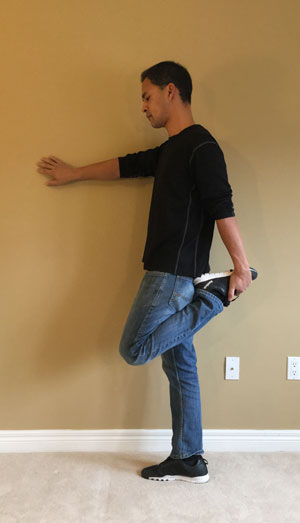
Allow gravity to relax your thigh down towards vertical. Do NOT pull on your foot.
4. Increase the angle to help bring your thigh down towards vertical. Use a very gentle pull on your foot to help facilitate this for you.
Be patient and allow the muscle time to truly release. Simply lowering to a vertical position is key. This action alone with bring some much needed relief for anyone with tight muscles, hip pain, knee pain and more.
The standard stretches that are encouraged generally do not emphasize the importance of just allowing the muscle to relax to vertical to prevent further strain and imbalance.
More emphasis is usually spent on pulling your knee behind you before your ensure a neutral tilt.
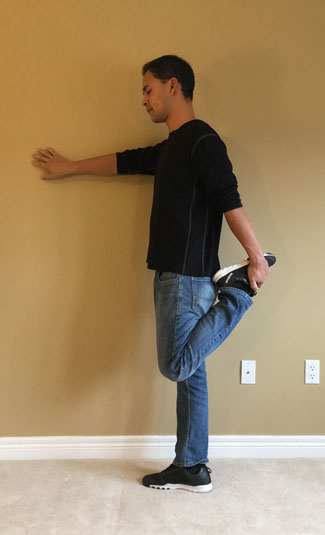
Keep your back straight and pelvis neutral while relaxing. Be careful to avoid pulling the foot. Only go as far as YOU can.
5. Once your thigh is relaxed to vertical. Contract your glute (butt) muscle to kick your leg backwards. This is similar to the ‘donkey kick exercise’. This is what you need to do to angle your thigh past vertical. Only hold your foot and do not pull.
By squeezing your butt muscles to ‘donkey kick’ behind you, you are using the power of your glutes to antagonize the Rf. This is not easy but it is important to practice.
It is a way to actively stretch your muscle after passively stretching/relaxing it with gravity. Also, at this point there is minimal strain on the knee joint and patella as you are not pulling on it, just supporting it.
What you see below is a moderate but effective stretch. Some people can go much further back. However to do this, your lower back will over flex which is not safe if you are prone to back problems.
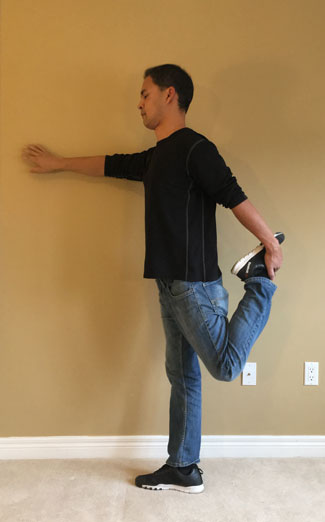
Squeeze your butt muscles to kick back slowly. Move your foot further behind and away from your bum.
To really benefit from the stretch, it should feel as though you are firmly clenching your bum to kick behind. This helps to ensure greater pelvic stability while maximizing your ability to lengthen the rectus femoris.
6. With your glutes contracted (butt squeezed), gently move your leg behind and AWAY from your butt. Do NOT pull upwards toward your head. Extend your leg behind you so that your foot is further away. Hold for up to 1 minute.
Many people have been taught just to grab from behind and pull. For the few that only have tight quads, this is not a problem. But for the rest of us, this is an unsafe practice as it risks injury to all of the joints affected.
If you are performing the stretch as safely as directed here, then the only sensation that you should experience is that of your quadriceps (including the Rf) being lengthened. It should not hurt your knee, hip or lower back.
Other variations of the stretch
There are 3 other popular ways to stretch your rectus femoris properly.
- While kneeling on the floor
- While lying on your side
- While on your couch

Stretching on your couch or bed will protect your knee also.
Both can be done using the above steps. As long as there is sufficient padding for your knee, it’s good to practice all 4 exercises at different times. Be sure not to over do it as that would only be counterproductive!
The benefits of standing to stretch vs. kneeling or lying
As long as you have access to a comfortable surface, all 4 exercise are equally beneficial.
The main benefit of learning this stretch as you are standing is that you can perform it anytime or anywhere you need to. There is no limitation on when or where you can do it.
This gives you the opportunity to quickly and proactively protect both the muscles and joints affected while on the go.
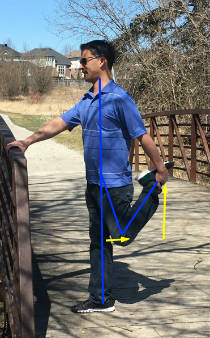
You can do it on the go while standing.
However, the few times where it is not practical to do it is when you are seated of course.
To be able to stretch your tight quads (and hip flexors) while seated, you can simply perform The Seated Lunge. It is one of the best methods to follow especially when you are at work and do NOT have the time to stretch or exercise.
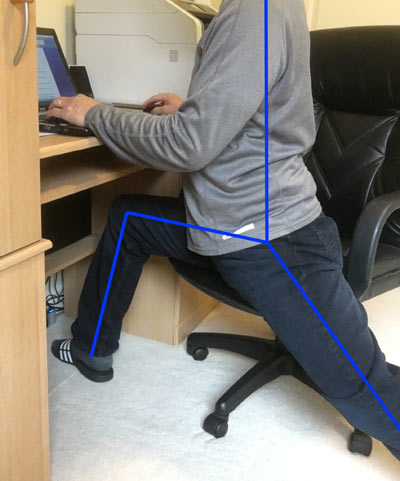
You can still do it while seated at work!
Go to the Seated Lunge for more help and learn 5 ways on how to relieve your pain while at work now!
This alternative way to stretch tight quads while seated also encourages you to engage your glutes. Not engaging the gluteal muscles while staying active (or from lack of activity such as sitting) will inevitably lead to tight quadricep muscles.
Be sure to include both a warming up and cooling down period whenever you’re exercising. Failure to do so causes your most active muscles to become stiffer, tighter and can make them increasingly prone to injury.
Is the pandemic affecting your physical activity? Would like more help with your quadriceps?
Learn how to deal with tight hip flexors
How to lunge to save your quadriceps
Test your quads now to see if you’re at risk
For references on this article
https://www.livestrong.com/article/500712-how-to-tell-if-your-quadriceps-are-tight/
